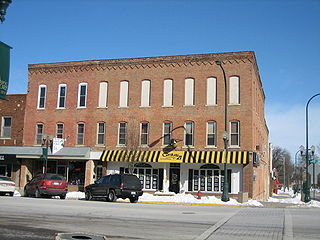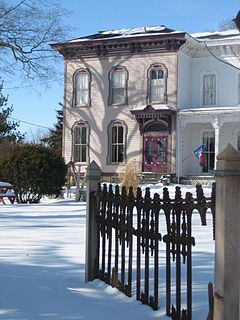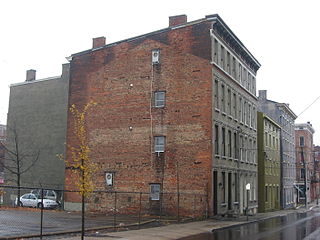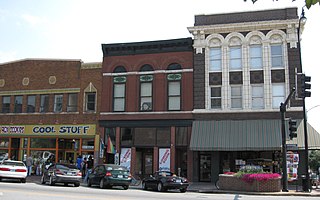
Sycamore is a city in DeKalb County, Illinois, United States. It has a commercial district based and centered on Illinois Route 64. The population was 17,519 at the 2010 census, up from 12,020 in 2000. As of 2019, the population has grown to an estimated 18,322. Sycamore is the county seat of DeKalb County and was named after the sycamore tree.

The Sycamore Historic District is a meandering area encompassing 99 acres (400,000 m2) of the land in and around the downtown of the DeKalb County, Illinois county seat, Sycamore. The area includes historic buildings and a number of historical and Victorian homes. Some significant structures are among those located within the Historic District including the DeKalb County Courthouse and the Sycamore Public Library. The district has been listed on the National Register of Historic Places since May 2, 1978.

The DeKalb County Courthouse is located in the county seat of DeKalb County, Illinois, U.S., the city of Sycamore. The Classical Revival structure sits on a square facing Illinois Route 64 as it passes through the city. The current courthouse was constructed in 1905 amid controversy over where the courthouse and thus, ultimately, the county seat would be located. The current building is the third structure to bear the name "DeKalb County Courthouse." DeKalb County's Courthouse still serves as the county's primary judicial center and is a contributing property to the Sycamore Historic District. The district joined the National Register of Historic Places in 1978. As the county's primary courthouse for over 100 years, the site has been host to many trials, including prominent murder cases.

The David Syme House is located in Sycamore, Illinois and is part of the Sycamore Historic District. The district was listed on the National Register of Historic Places in May 1978. The Queen Anne style home was constructed sometime around 1880.

The Frederick Townsend Garage is located in Sycamore, Illinois and is listed on the National Register of Historic Places as part of the Sycamore Historic District. It sits at the base of a small incline overlooked by the large Queen Anne style Townsend House. First a gas station, the building has been used by a number of restaurants since then. It was restored and remodeled for use as a community bank in 2016. The Sycamore Historic District was listed on the Register in May 1978.

The George's Block, once known as the James Block, is a 19th-century structure located in Sycamore, Illinois, along Illinois Route 64 as it passes through the DeKalb County seat. The Block is part of the Sycamore Historic District and as such is listed on the National Register of Historic Places. The district joined the Register in May 1978. The building dates from 1857 when it was owned by Daniel P. James but by the 1860s the building has become known as George's Block.

The Civil War Memorial, in the DeKalb County county seat of Sycamore, Illinois, United States, is located in front of the DeKalb County Courthouse on a public square. The memorial was erected in 1896 and dedicated in 1897. The structure is a memorial to the thousands of DeKalb County residents who served in the American Civil War. It incorporates an obelisk which rises to 50 feet in height. The base is adorned with copper sculpture, completed by an unknown sculptor. On the east facade of the memorial the word "Antietam", denoting the Battle of Antietam, is misspelled. This work of public art underwent its first restoration work in 2005-2006.

Old Sycamore Hospital is two-story brick structure in downtown Sycamore, Illinois, United States. It is a contributing structure within the Sycamore Historic District. The district was established when it was added to the National Register of Historic Places in 1978. The hospital building is located at the corner of Elm and Somonauk Streets in Sycamore.

The Charles O. Boynton Carriage House is a prominent structure in the Sycamore Historic District, located in Sycamore, Illinois. The Sycamore Historic District was added to the National Register of Historic Places in 1978. The Carriage House is considered one of more than 150 contributing properties to the overall historic integrity of the district.

The Peter Johnsen Rooming House is an historic building near downtown Sycamore, Illinois. The red brick structure stands in the 100 block of South Main Street and is considered a contributing structure to the overall historic integrity of the Sycamore Historic District. The district was added to the National Register of Historic Places in May 1978.

The houses in the Sycamore Historic District, in Sycamore, Illinois, United States, cross a variety of architectural styles and span from the 1830s to the early 20th century. There are 187 contributing properties within the historic district, 75% of the districts buildings. Many of the homes are associated with early Sycamore residents, usually prominent business leaders or politicians. Houses within the district are known by, either their street address or by a name associated with a prominent owner or builder. For most of the houses, the latter is true.

As of 2007 there are five church buildings in the Sycamore Historic District, located in Sycamore, Illinois, United States which are listed as contributing properties to the district. The Sycamore Historic District was added to the U.S. National Register of Historic Places on May 2, 1978. When it was nominated to join the National Register there were seven church buildings within the district. One of those included is a residential structure that was utilized as a church when it was first constructed; the Arthur Stark House was once home to the Sycamore Universalist Church congregation. In the time since its listing, two churches have been destroyed or demolished. The Evangelical Church of St. John was destroyed by fire in 2004 and the United Methodist Church in Sycamore is no longer extant, replaced by a modern office building.

The commercial buildings in the Sycamore Historic District, located in Sycamore, Illinois, United States are mostly located in and around the city's downtown. The largest concentration of commercial contributing properties to the historic district are found along Illinois Route 64 as it passes through Sycamore. They include several buildings known as "blocks" which can consist of more than one adjacent and attached structure, as is the case with the Waterman Block, one of the Sycamore commercial buildings.

Krippendorf-Dittman Company is a registered historic building in Cincinnati, Ohio, listed in the National Register on March 3, 1980.

The Sycamore-13th Street Grouping is a cluster of historic buildings in the Over-the-Rhine neighborhood of Cincinnati, Ohio, United States. Built during the middle and later years of the nineteenth century, these eighteen buildings are built of brick and sandstone with elements of stone and iron. Some of the buildings feature elements of the Greek Revival, Italianate, or Queen Anne styles of architecture, but the majority of the buildings in the cluster are simple vernacular structures. Virtually all of the buildings in the grouping were constructed for residential purposes, although some were built exclusively as apartment buildings, while some originally had both residential and commercial space. The structures built as commercial-and-residential buildings are those most likely to feature defined architectural styles, rather than vernacular designs.

The Eighth and Broadway Historic District is one of the seven national historic districts located in Columbia, Missouri. The district is made up of three contributing properties and is located at the intersection of Eighth and Broadway Streets in Downtown Columbia. They consist of the Beaux-Arts style Miller Building (1910), the Italianate style Matthews Hardware, and the Art Deco style Metropolitan Building. Today, the area holds loft apartments and several local business including Rally House, Sycamore, Peace Nook, and Geisha.

The Prospect Avenue Historic District encompasses a predominantly residential area in western Hartford and eastern West Hartford, Connecticut. The 300-acre (120 ha) historic district extends along Prospect Avenue from Albany Avenue to Fern Street, including most of the area between those streets and the Park River to the east, and Sycamore Street and Sycamore Lane to the west. The district includes 240 contributing buildings and 48 non-contributing buildings, most of them residences built between 1880 and 1930. The district was listed on the National Register of Historic Places in 1985.

The Rath Packing Company Administration Building, also known as Adams Store Inc., is a historic Late Gothic Revival building in Waterloo, Iowa.

The Marsh–Place Building at 627 Sycamore St. in Waterloo, Iowa is a six-story building built in 1910. According to its nomination to the National Register of Historic Places, it is notable as "a distinctive, virtually unaltered example of the Commercial Style". And it is an "excellent" example of "the three-part base-shaft-capital approach to tall building design."

Rankin's was a department store at 117 W. Fourth Street at Sycamore in downtown Santa Ana, California. The Rankin Building is listed on the National Register of Historic Places on its own and also as a contributing property of the Downtown Santa Ana Historic Districts.



















